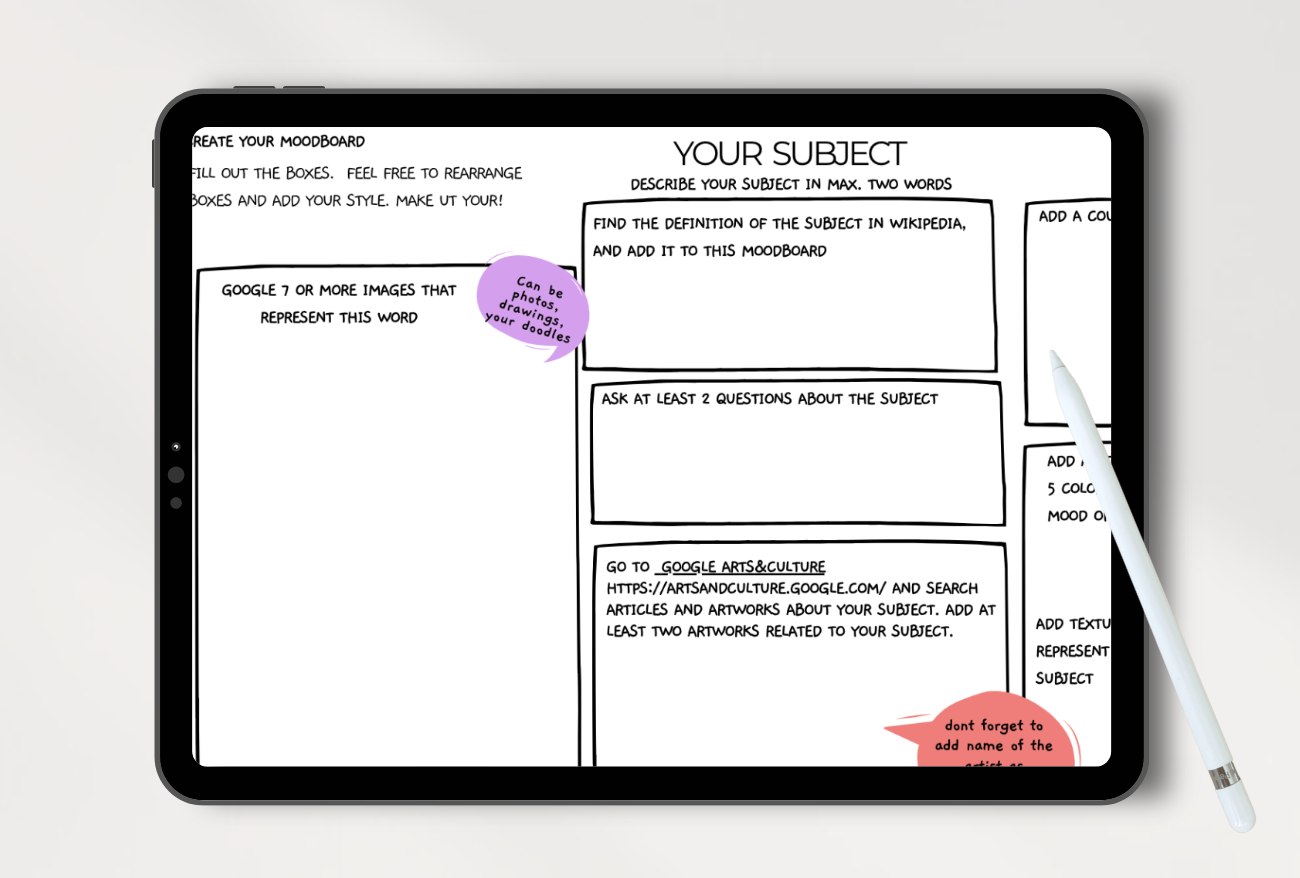Virtual Collaboration Frameworks
Designed and developed pre-established frameworks within Miro to encourage students to gain a deeper understanding of their inquiry-based questions and processes. Establishing these preset frameworks in Miro fosters comprehensive exploration and comprehension among students as they delve into their inquiries and engage in various processes. This strategic approach aims to enhance the overall learning experience by providing a structured and supportive environment that empowers students to navigate their inquiries with a greater depth of understanding.
Problem
Art teachers face challenges in motivating students to consistently engage with art concepts and encourage more profound analysis, synthesis, and textual production in inquiry-based exams such as AP Art Language and Literature.
In addressing this issue, I developed a series of virtual collaboration classes to assist students in exploring one another's ideas about their subject matter, gathering additional information, and emulating thinking and writing processes.
Data Analisys
Learners
The measurement of students' engagement in deeper interaction and critical thinking was conducted through a dual approach, employing both quantitative and qualitative research methodologies. Quantitative research was utilized to gather numerical data and statistical insights (with Google Survey), allowing for a systematic analysis of the extent of student engagement. This involved using measurable metrics to assess the frequency and intensity of interactions and the level of critical thinking demonstrated by students.
Complementing the quantitative aspect, qualitative research provided a more in-depth understanding of students' experiences and perspectives. This involved collecting and analyzing non-numerical data, such as students' reflections, narratives, and observations. This research helps to identify factors influencing students' engagement, offering a richer and more comprehensive insight into the depth of their interaction and thinking processes.
The survey reveals the correlation between students' expectations, positive outcomes of digital tools, and their response to the instructional equity lens.
Objectives & Components
Collecting Data. Mind Map
By the end of this task, you will know: How to engage with and utilize pre-existing artistic concepts, materials, and sources to enhance and expand your authentic creative ideas
You will be able to create a mind map of text and visual metaphors representing your artistic response to our big question.
Bull Eye Chat for Peer Review
By the end of this task, you will know how to broaden ideas and gather content for complex art project by exploring subject matter from different perspectives and cultural experiences.
You will be able to analyze and explore the hypothesis put forth by others regarding our subject matter with the ThinkTank 2: Bull Eye Chart
Moodboard
By the end of this task, user will know how to define/adjust a visual direction for your further AP SI portfolio based on your previous findings.
User will be able to create a mood board representing a visual direction for your SI and use it as a part of your SI portfolio.
Evaluation
Assessment of the methodology involved students actively participating in virtual collaboration during the peer review stage, employing a Bullseye chart. Additionally, students demonstrated enthusiasm for engaging in verbal discussions concerning each other's mood boards. A noteworthy observation was that a majority of the students not only successfully completed all three tasks but also exhibited a high level of collaboration in both their individual components and the peer review segment.
The implementation of pre-set frameworks played a pivotal role in affording students the opportunity to delve into the intricacies of the thinking process. These frameworks not only guided them through the exploration of their inquiry-based themes but also facilitated the incorporation of their unique perspectives and modes of exploration. Consequently, the evaluation highlighted the effectiveness of the method in fostering comprehensive engagement, as students not only met the prescribed tasks but actively contributed to and expanded upon the various facets of their inquiry-based themes.
Course Sequence
Course Architecture, Learning Sequences, and UDL Instructional Materials Based for 2D Art Portfolio Course, designed for secondary and higher ed teachers.
Tools: Miro, Photoshop XD, GSites
Lesson Sample
Set of slides and differentiated worksheets designed for Moodboard Activity fostering a connection between text and images.
Tools: Figma, Photoshop XD, Canva, GSlides
Blog Post
My Edutopia article details how combining essential ed-tech tools with visual-thinking frameworks created a resilient learning community, empowering students to face challenges with a strong sense of belonging.







